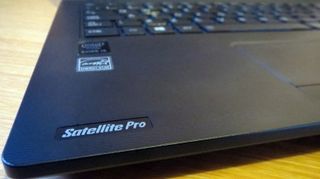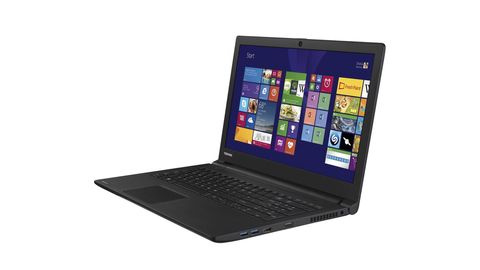Why you can trust TechRadar
Benchmarks
- PCMark 8 Home: 2,167
- PCMark 8 Home battery life balanced 50% screen: 3hr 43mins
- PCMark 8 Home battery life power saver 25% screen: 4hrs 46mins
- PC Mark 8 Home High Performance 100% screen battery life: 3hrs 2mins
- 3DMark: Ice Storm: 33,030; Cloud Gate: 3,943; Fire Strike: 489
- Cinebench R11.5: CPU: 2.55; Graphics: 14.84fps
- Cinebench R15: CPU: 231cb; Graphics: 18.76fps

The unfussy specification returned a middling set of benchmark results. In PC Mark 8's Home test the R50 scored 2,167 points – a little behind the HP Envy 15 x360, which scored 2,322 points with the same processor – a lead that's likely caused by the HP's 8GB of RAM. The Dell Inspiron 15 7000, with its Core i7 silicon, outpaced both systems with a result of 2,493.
The Toshiba settled into third place in the Cinebench R15 CPU test, too. It scored 231cb, which was six points behind the HP but further behind the Inspiron, which scored 255cb.
This is no gaming laptop, either. Intel's integrated graphics core stumbled to a result of 33,030 in the 3D Mark Ice Storm test – more than 4,000 points behind the HP laptop, and almost 15,000 points behind the Dell and its discrete Nvidia graphics core.
The 5,400rpm hard disk didn't help matters in any of our benchmarks. Its sequential read and write speeds of 95MB/s and 82MB/s are slow, even for platter-based hardware.
The middling specification had one upside: no thermal problems. The R50 stayed cool and quiet in every benchmark, and none of its added heat was transferred to the chassis during stress-tests.
Battery life wasn't bad, either. In PC Mark 8's Home battery benchmark the R50 lasted for 3hrs 43mins, which was ten minutes longer than the Dell but ten minutes less than the HP.
Screen
The R50 has a non-touch screen with a resolution of 1,366 x 768. That's standard for this class of machine, but it's restrictive for both work and play. The lack of pixels mean that it's tricky to work with multiple windows or large applications, and the sub-HD resolution means 1080p movies can't play at their full fidelity.
The 233cd/m2 brightness is good, but the R50 faltered elsewhere. Colour accuracy is no good thanks to a wayward Delta E of 8.18 and a cold colour temperature of 6,931. The latter figure means that colours lack vibrancy, while the former result means this panel is no good for colour-dependant work.
The 1.01cd/m2 measured black level is far too high, and it contributes to a poor contrast ratio of 231:1. The high black level means that the darkest shades appear as underwhelming greys rather than anything deeper, and the poor contrast hinders depth and distinction of colours across the entire range.
The low resolution and poor quality mean this screen is only suitable for web browsing, word processing and other less intensive tasks. The HP's screen suffers from similar problems – a low resolution and a lack of quality – while the Dell streaks ahead with a Full HD resolution, touch control and better quality.
Mike has worked as a technology journalist for more than a decade and has written for most of the UK’s big technology titles alongside numerous global outlets. He loves PCs, laptops and any new hardware, and covers everything from the latest business trends to high-end gaming gear.

